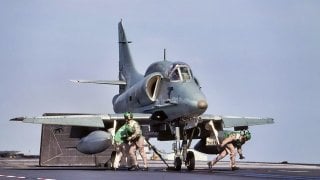A-4 Skyhawk: The Navy's Mini 'Bomber' Built to Kill Anything on Land
Today, nearly seven decades after the aircraft took its first flight in 1954, some A-4 Skyhawks remain in service with the Argentine Air Force and the Brazilian Naval Aviation.
Douglas A-4 Skyhawk Facts - Developed for the United States Navy and the United States Marine Corps in the early 1950s, the Douglas A-4 Skyhawk went on to play a key role in the Vietnam War as the U.S. Navy's first-line aircraft, where it was noted for its unusual accuracy in attacking selected ground targets. The Skyhawk also saw action in other global conflicts including the Yom Kippur War and the Falklands War.
Today, nearly seven decades after the aircraft took its first flight in 1954, some A-4 Skyhawks remain in service with the Argentine Air Force and the Brazilian Naval Aviation.
A-4 Skyhawk: Versatile Light Attack-Bomber
U.S. Navy experts had been highly skeptical of the claim of Ed Heinemann, chief engineer of what was then called the Douglas El Segundo, that he could build a jet attack bomber weighing half the 30,000 pounds specified. He proved those critics wrong, and the result was a single-seat, subsonic carrier-based attack aircraft.
It was also very fast; and the first XA4D-1 prototype – dubbed "Heinemann's Hot Rod" – set a world speed record of 695.163 mph on October 15, 1955. The 7,200 lb.-thrust Curtiss-Wright J65-W-2 engines powered the first Skyhawks, but production models, A-4D-ls (A-4As), used 7,700 lb.-thrust J65-W-4 engines.
The first Skyhawks were delivered to Navy Attack Squadron VA-72 in October 1956.
Heavy Bomb Load
Despite having a maximum takeoff weight of 24,500 pounds, the aircraft's five hardpoints supported a variety of missiles, bombs, and other munitions. The A-4 Skyhawk was capable of carrying a bomb load equivalent to that of a World War II-era Boeing B-17 bomber – a fact that is notable as entered service less than a decade after the Flying Fortresses had been used to bomb German cities.
The Skyhawk could also deliver nuclear weapons using a low altitude bombing system and a "loft" delivery technique.
Skyhawks were the U.S. Navy's primary light attack aircraft used over North Vietnam during the early years of the Vietnam War, while a U.S. Marine Corps Skyhawk is believed to have dropped the last American bombs on the country.
Wing Design
Unlike most other carrier-based aircraft, the Skyhawk was designed with a relatively small wingspan, and as a result did not have folding wings. The elimination of that feature allowed a much simpler, lighter wing, which in turn allowed a much lighter aircraft.
In addition, because the delta-shaped wing was made in a single unit, it formed an integral fuel unit.
Multi-Versions
Between 1956 and 1979 nearly 3,000 Skyhawks were produced in a number of configurations. In addition to serving as the U.S. Navy's first-line fighter-bomber, the A-4 served in a number of roles, including as an aggressor aircraft and as advanced trainers, the latter aircraft designated TA-4s with a two-seat cockpit.
During the years 1974-1986, the A-4 also equipped the Blue Angels Navy Flight Demonstration Squadron. The Navy retired its last Skyhawk in 2003, a full 51 years after the sea service issued a contract for the first prototype of the aircraft.
War in Vietnam
In the skies over Vietnam, the A-4 Skyhawk logged more combat missions than any other naval aircraft, and it took part in notable strikes against bridges and power plants in North Vietnam, and also provided close air support of troops engaged in ground combat in South Vietnam.
It was U.S. Navy A-4s that participated in the first strikes of the Vietnam War in response to attacks against American destroyers in the Tonkin Gulf in August 1964. The Skyhawk was the first U.S. aircraft to drop ordnance on the enemy. A Skyhawk flown by Lieutenant (junior grade) Everett Alvarez was shot down during the raids, and after ejecting from his aircraft, he became the first naval aviator taken prisoner during the Vietnam War.
In total, 195 carrier-based Skyhawks fell to enemy fire during the Vietnam War, and among the pilots forced to eject from them and taken prisoner Medal of Honor recipient Commander (later Vice Admiral) James B. Stockdale and Lieutenant Commander (later Senator) John S. McCain, III. While flying close air support on September 26, 1972, Marine Corps Captain James Walsh was hit by ground fire and was forced to eject from the aircraft. He was the last Marine to be taken prisoner during the Vietnam War.
Among those who made the ultimate sacrifice was Lieutenant Commander Michael Estocin, who during a flight on April 20, 1967, successfully neutralized three surface-to-air missile sites in a strike over Haiphong, North Vietnam and subsequently made a fiery carrier landing in his badly damaged A-4. He was shot down five days later and received the Medal of Honor posthumously.
About the Author
Peter Suciu is a Michigan-based writer who has contributed to more than four dozen magazines, newspapers and websites. He regularly writes about military hardware, and is the author of several books on military headgear including A Gallery of Military Headdress, which is available on Amazon.com. Peter is also a Contributing Writer for Forbes.
Image Credit: Creative Commons.


